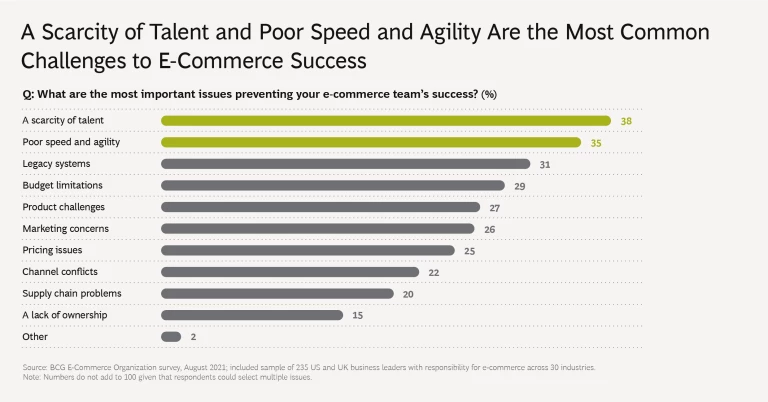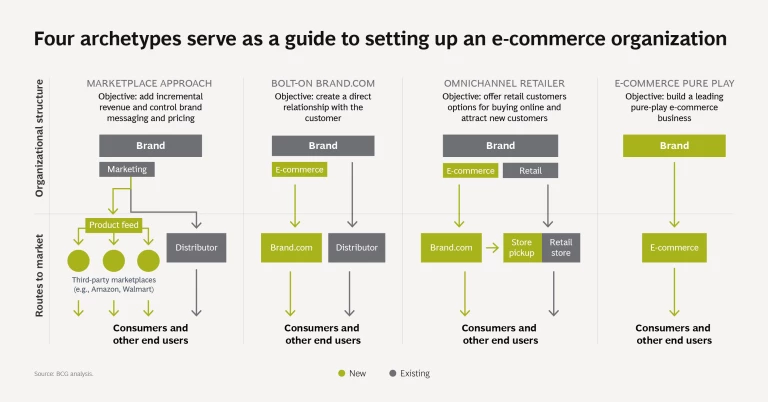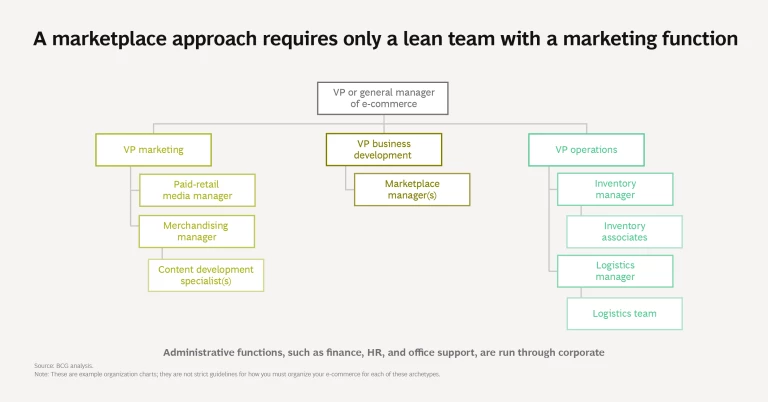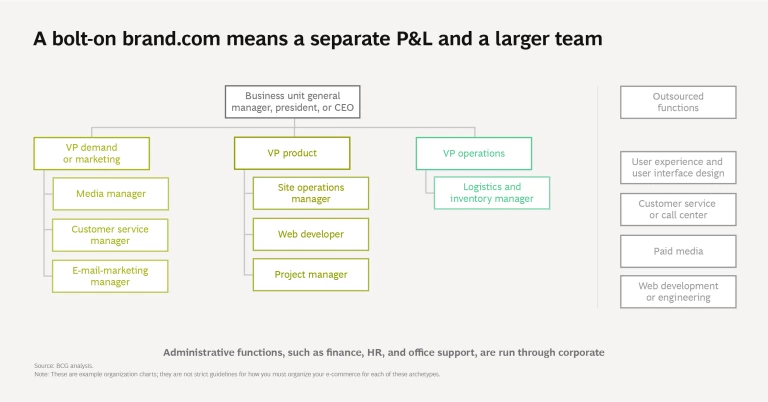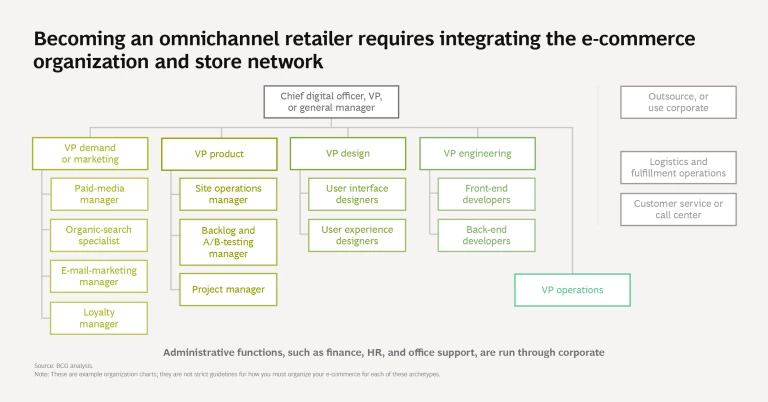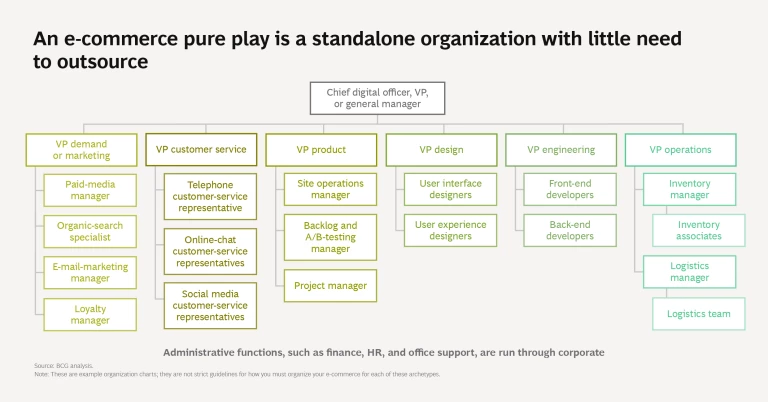Don’t let complexity stymie your online-sales operation. Simplify your approach by clearly defining business objectives, then choosing one of four e-commerce archetypes.
Online sales have climbed 35% during the pandemic and show no signs of slowing . As a result, 88% of e-commerce organizations in North America and the UK report that they grew in 2020 and 94% say they will expand further in 2021-2022, according to a recent BCG survey. As they do, business leaders are discovering the enormous complexity of building, maintaining, and expanding an e-commerce operation.
Perfecting the technology is not enough in this digital transformation ; in fact, the organizational challenges can often be as great—if not greater—than the technical ones. Our survey reveals many common obstacles such as a lack of available talent, poor speed and agility, legacy systems, budget limitations, and product, marketing, and pricing issues. (See the exhibit.)
E-Commerce Organizational Complexity
This complexity has many sources, including the need to collaborate across functions—marketing, sales, merchandising, and fulfillment, for example—and the necessity of recruiting and training multidisciplinary experts with diverse skills, from marketing to web development to fulfillment operations.
In addition, complexity may come from:
- Decentralized teams, which boost customer centricity but introduce variance across the company
- The need to scale and evolve quickly to keep up with rapid e-commerce growth and changing customer needs
- Channel partners that have conflicting agendas, with 38% of e-commerce channel managers saying these conflicts are their top business concern
- A wide array of reporting lines and leadership structures
One organization describes complexity in the online-sales operation as “the goo that slows everything down.” In fact, unnecessary or unmanaged complexity manifests in many ways, including tension and inefficiency among global and local teams that have different priorities or share hybrid resources. Moreover, the skills needed to support the e-commerce group may not be supplied at the right levels by corporate functions, causing strife.
Choose an Archetype
The best way to tame this complexity is to clearly define business objectives and then build an e-commerce organization that aligns with those goals. We recommend that companies focus not just on the digital technologies but on how their teams will work together to use these tools to their full potential. They can accomplish this by choosing one of the four following archetypes as a guide. (See the slideshow.)
A Marketplace Approach. Is the business simply aiming to diversify its retail channels, with minimal effort? In that case, creating an organization that sells online through an existing marketplace, such as Amazon, could be the right choice. The company itself will require only a lean team within the marketing function.
- Critical hires will include a content development specialist, retail paid-media manager, and fulfillment operations director.
- Key initiatives will comprise the development of content for product pages, optimization of sponsored advertising, and coordination across owned distribution centers (DCs) and direct-to-consumer (DTC) fulfillment services.
A Bolt-On “Brand.com.” Is the organization looking to build its own DTC relationship? In that case, it may choose to set up a separate P&L for the e-commerce business and hire a larger team—but still outsource some functions. This team would commonly report to the company’s chief digital officer.
- Critical hires will include a web development lead along with a front-end engineering team, paid-search and social media manager, and fulfillment operations director.
- Key initiatives will comprise the creation of a functioning and effective online storefront, demand generation, and fulfillment.
An Omnichannel Retailer. Is the business focused on creating an experience that allows in-store customers to shop online? This approach is more technically challenging, given the integration required between the e-commerce organization and the store network.
- Critical hires will include in-store fulfillment teams, a full stack technology team dedicated to e-commerce, and digital marketing specialists.
- Key initiatives will comprise the creation of buy-online and pickup-in-store (BOPIS) and ship-from-store (SFS) capabilities, technology stack evolution, and an optimized online customer experience .
An E-Commerce Pure Play. Is the company a pure-play e-commerce business looking for growth? This will be a standalone online-sales organization with its own P&L. It will focus on developing its unique and compelling customer experience as it expands, and technical excellence and agility across functional specialties must become core aspects of the operation. As such, the enterprise is likely to build in-house capabilities, resulting in little need to outsource core functions.
- Critical hires to in-house staff (in addition to web developers and logistics personnel) will include customer acquisition and marketing specialists, user experience designers, and product managers.
- Key growth initiatives will comprise demand generation (from both new and existing customers), improvement of the user interface and experience, and marketplace expansion, substitution, and possibly reseller management.
Get the Basics Right
The chosen archetype will dictate the staff required for the growing organization. Recruitment and career paths for the specific skill sets will be critical, as the market for this talent is highly competitive and finding replacements can be difficult.
At a minimum, all companies will need to build or manage a basic e-commerce platform and an analytics system to measure progress, while putting a strong leader in charge of each key function. Successful organizations tend to invest heavily in centralized data analytics, which serve as the primary source of truth and direct customer contact. In addition, these businesses make sure to gain buy-in from senior executives about the enterprise’s strategic purpose within the broader company; it’s best to know where e-commerce intersects with the rest of the operation and ensure that it has good support from leadership.
How Will the Organization Grow?
Regardless of the chosen archetype, businesses will need to periodically revisit the e-commerce organization as it scales. Adding individual brand- or category-level sites will allow more customization and differentiated experiences—but create far more technical and operational complexity. Retaining an integrated site, in contrast, will be less complicated but may not capture the full breadth of the business. Similarly, when expanding to new regions, it will be more efficient and cost-effective to centralize some functions, such as technology, but this choice will inevitably reduce customization as well as brand advocacy.
Keep These Things in Mind
As leaders establish or expand the new e-commerce organization, they should also be sure to:
- Centralize platform development, technology, and theme design but let brands manage their own copy, customer service, and photography.
- Take a balanced approach to outsourcing: it can increase bandwidth, but overreliance on outsourcing can lead to underperformance and missed opportunities.
- Be prepared to make tradeoffs as the business grows or switches to a new archetype.
- Get started right away and then iterate, rather than waiting to build the perfect solution.

